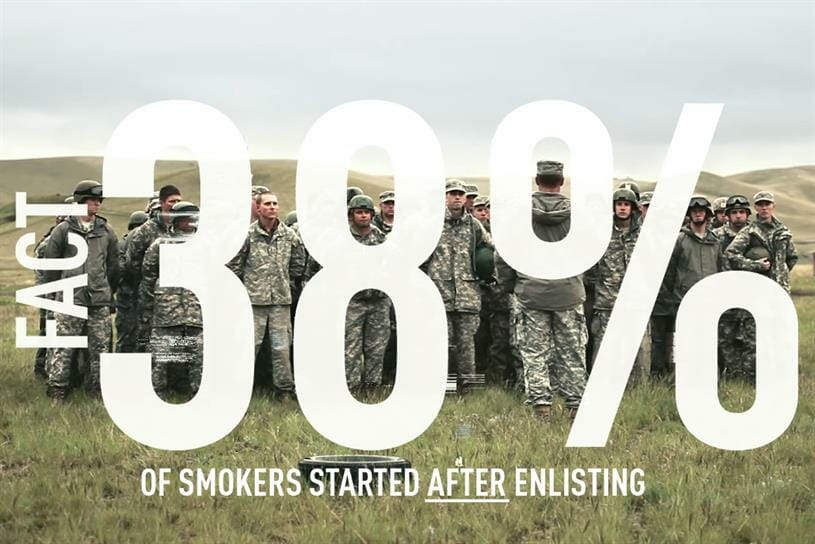 Truth Initiative today released a duo of videos, set to air during the MTV VMAs on Aug. 27th, that add smoking to the conversation.
Truth Initiative today released a duo of videos, set to air during the MTV VMAs on Aug. 27th, that add smoking to the conversation.
As conversations about identity and social justice continue to dominate the national dialogue, the anti-smoking Truth Initiative today released a duo of videos, set to air during the MTV VMAs on Aug. 27th, that add smoking to the conversation. Over the course of a minute each, the videos trace how the tobacco industry has targeted military personnel and mental health patients as ideally positioned to become smokers, a revelation that Truth hopes will outrage the VMAs’ woke-teen viewers.
See also: How Truth Initiative grew an online community
“It’s a ripe climate for this kind of dialogue,” said Nicole Dorrler, Truth’s SVP of marketing. “Young people are having conversations right now about the ways people are being labeled, and Big Tobacco is unlike any other industry because they’ve systematically profiled, exploited and profited from various populations by selling them a deadly product.”
This isn’t the first time Truth has examined the industry’s history of identity-based marketing: previous campaigns have included segments on tactics aimed to hook poor mothers, low-income schoolchildren, African-Americans, and the LGBT community. “There’s unfortunately not a single group of people that hasn’t been targeted by this industry for generations,” said Dorrler.
The “Business or Exploitation?” campaign focuses on details from internal tobacco industry memos that Truth acquired through a lawsuit settlement. Based on psychological profiling that described troops as “less educated” with “limited job prospects” and “part of the ‘wrong crowd,'” and characterized anxiety and depression sufferers as ideally vulnerable targets, tobacco companies began in the 1970s to distribute free product to psychiatric facilities and military bases. “They have done this for decades, and we’re experiencing the repercussions now,” Dorrler explained. Mental illness survivors consume 40 percent of cigarettes smoked in the US, and 38 percent of veterans who smoke only began doing so after enlisting.
With their journalistic tone and heavy subject matter, the spots are a departure from “Squadless,” Truth’s campaign for last year’s VMAs. Those videos used social media influencers and a jokey vibe to warn viewers of the FOMO (fear of missing out) they risked feeling by spending money on cigarettes instead of experiences with friends.
See also: Apple helps a blind drummer and nonverbal teen thrive in new spots
But getting teens’ attention about serious issues required a different approach, said Bryan Smith, an executive strategy director at 72andSunny. “We wanted to call bullshit on Big Tobacco using the tools of modern journalism, to get out of the way of the truth and report on it, and we knew from talking to young people that what gets them on board with the truth was hearing it corroborated by many different sides.”
Rather than “figuring out how to imagine something,” as 72’s creative team normally does, “we were working like journalists,” said Smith. With Truth’s help, the firm brought on former VICE News correspondents Kaj Larsen (who’s also a former Navy SEAL) and Ryan Duffy, who helped to pioneer an edgy style of video journalism familiar to young people. Through interviews with real-life veterans and mental illness survivors, they put relatable, emotion-provoking faces on the disturbing history and statistics that inspired this campaign.
See also: How Ascension’s Nick Ragone is rebranding one of the biggest U.S. health systems
“This generation is seeing fake news, a lot of agenda-driven messages, and what Truth has always done well is provided unbiased information that allows youth to make their own decisions,” said Dorrler. “We say, don’t take our word for it, go look at these sources yourself.”
The campaign is, in a certain way, a return to form for Truth, which burst into the national conversation in 2000, after years of largely failed anti-smoking campaigns from other organizations that focused on shaming or lecturing young people. Their “Body Bags” spot, which used powerful, stark visuals to illustrated the 1200-person daily death toll of cigarettes, has since been credited with keeping at least 450,000 teens from taking up smoking. “That was guerrilla journalism,” said Smith, “so journalism is really the root of Truth.”
This story was first published in Campaign.







